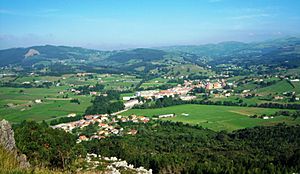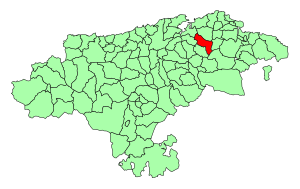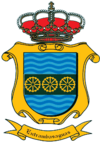Entrambasaguas facts for kids
Quick facts for kids
Entrambasaguas
|
||
|---|---|---|

View to the village of Entrambasaguas from the Vizmaya Peak.
|
||
|
||

Location of Entrambasaguas
|
||
| Country | ||
| Autonomous community | ||
| Province | Cantabria | |
| Comarca | Trasmiera | |
| Judicial district | Medio Cudeyo | |
| Capital | Entrambasaguas | |
| Area | ||
| • Total | 43.2 km2 (16.7 sq mi) | |
| Elevation | 45 m (148 ft) | |
| Population
(2018)
|
||
| • Total | 5,090 | |
| • Density | 117.82/km2 (305.2/sq mi) | |
| Time zone | UTC+1 (CET) | |
| • Summer (DST) | UTC+2 (CEST) | |
Entrambasaguas is a small town in Cantabria, Spain. It is about 25 kilometers (15 miles) south of the Bay of Santander.
This area has some mountains and is where the Aguanaz River begins. This river was once very important, powering 23 watermills! It later joins the Miera River. You can find ancient caves here with amazing rock art from the Paleolithic (Stone Age) and burial sites from the Bronze Age.
People have mined iron here since ancient times. This iron was used to make cannons for the Royal Artillery Factory of La Cavada, which supplied the Spanish Armada. This brought a lot of wealth to the area during the Renaissance.
Entrambasaguas was first mentioned in 1210. It is a green, rural area with six towns. It covers about 43 square kilometers (16.6 square miles) and has around 5,000 people. The population has almost doubled since 2005!
Contents
Geography of Entrambasaguas
Entrambasaguas is one of 102 towns in Cantabria. It is part of the Trasmiera region, which means "behind the Miera River". The town is located about 25 kilometers (15 miles) southeast of the bay of Santander.
Nearby towns include Ribamontán al Monte, Marina de Cudeyo, Medio Cudeyo, Riotuerto, and Solórzano.
Towns and Area
Entrambasaguas is made up of six smaller towns:
- Entrambasaguas (the main town)
- El Bosque
- Navajeda
- Puente Aguero
- Hornedo
- Hoznayo
- Santa Marina
These towns cover an area of 43.2 square kilometers (16.68 square miles).
Mountains and Rivers
Entrambasaguas has a gently rolling landscape. Two rivers, the Miera River and its smaller branch, the Aguanaz, flow through the area. The landscape is mostly rural, with moderate mountains, forests, and cow pastures.
Mount Vizmaya is a 249-meter (817-foot) high limestone mountain. It has several caves and the remains of an old castle at its top. You can also find old iron mines and lime kilns from the 1800s here.
The Miera River is one of Cantabria's most important rivers. It is a protected natural area because it helps preserve habitats and endangered species. The Miera River is also a good place for fishing.
The Aguanaz River starts from a natural spring in the San Antonio area. It flows through Entrambasaguas and Hoznayo before joining the Miera River.
Nature and Wildlife
Entrambasaguas has several shared mountain forests. These forests have eucalyptus trees, as well as native trees like oaks, beeches, and birches. You can also find pine trees and a barberry shrub. This shrub has edible fruits when cooked.
A rare tree in Cantabria, the poisonous Laburnum anagyroides (also called "rain of gold" because of its yellow flowers), also grows here. The area has a hunting ground with rabbits, deer, and wild boar. While there are no big mountain trails, there are paths around Mount Vizmaya and through the villages.
History of Entrambasaguas
People have lived in Entrambasaguas since ancient times. Many sites show that people lived here from the Paleolithic (Stone Age) through the Bronze Age.
Ancient Discoveries
- In Hoznayo, there are two Paleolithic caves: Recueva Cave and Cueva del Francés.
- Navajeda Cave was explored in 1922. It contained Stone Age layers and burial sites from the Bronze Age.
- Other caves like Cueva del Eucaliptal, "cueva de Bocarones," and "cueva de los Murciélagos" (Bat Cave) also have Bronze Age items and cave paintings.
Medieval Times
Two sites from the Middle Ages are the upper burial ground of Entrambasaguas (from the 9th to 12th centuries) and Mount Vizmaya. Mount Vizmaya has pottery pieces and buildings from the time of the Reconquista.
In medieval times, the area was known as "Entre amas aguas," meaning "between the two waters." This likely referred to its many water channels. The Aguanaz River was very important, bringing wealth to settlers who built water mills and flour mills.
The town was first officially mentioned in 1210. Later, it came under the rule of the Agüero family. Iron mines in the area supplied minerals to cannon factories, including the Royal Artillery Factory of La Cavada. This factory operated from 1637 to 1835.
Cultural Heritage
The history of Entrambasaguas is closely linked to its rivers. Many important cultural sites are related to water.
Water-Related Heritage
- Fuente del Francés Spa: This spa opened in the late 1870s. It had four natural hot springs with warm, mineral-rich water. Although the spa declined, some parts of the old mill from the spa are still standing.
- Water Mills: A total of 23 water mills once operated in Entrambasaguas, mostly on the Aguanaz River. The town's official coat of arms even shows three water wheels! These mills were very important for grinding grain. Even during droughts, these mills often had enough water to keep working. Today, 14 of the original mills remain, but none are active.
- Max Milk Powder Factory: This old factory in San Antonio is an example of 1930s industrial architecture. It was built by a German pharmacist named Maximilian Berlowitz Feinstein. He chose Entrambasaguas because it had many cows, good food for them, and clean water from the Aguanaz River. Today, the factory is an environmental education center for children.
- Puente Agüero Bridge: This bridge over the Miera River was built in the Middle Ages. It was very important for travel between the east and west. The bridge was rebuilt in 1737 and restored again in 2001.
Important Buildings
Two palaces in Entrambasaguas are recognized as important historical monuments:
- The Palace of Acebedo of Hoznayo (from the 17th century)
- The Palace of Fernández de Velasco (from the 18th century)
Many old doorways (portals) in Entrambasaguas are also considered cultural heritage. These include portals in Hoznayo, Entrambasaguas proper, and Hornedo. Some, like the Carasa Arredondo portal from around 1680, are famous for their beautiful stonework.
Population Changes
Throughout the 1900s, the population of Entrambasaguas decreased. Many people moved to the larger city of Santander, especially after the 1970s. Most people live in the main town of Entrambasaguas.
However, since 2004, the population has almost doubled! This shows that more people are choosing to live in Entrambasaguas now.
Getting Around Entrambasaguas
You can reach Entrambasaguas by car, bus, or train.
By Car
- Highways: You can use the A8 highway from Bilbao or Santander. Take exit 194 or 197 in Hoznayo.
- National Roads: The N-634 national highway also passes through the area.
- Local Roads: A network of regional roads connects Entrambasaguas to nearby towns and areas.
By Train
As of 2016, you can take a FEVE train from Santander to Lierganes. It stops in the nearby town of Solares.
By Bus
The nearest ALSA bus stop for Entrambasaguas is in Solares. Buses to Santander, for example, stop every 60 minutes.
Local Government and Economy
Local Government
In the 2015 local elections, the People's Party (PP) won the most votes. They kept their majority in the local government.
The main judicial office for Entrambasaguas is in Medio Cudeyo, located in Solares. This is where things like property records are kept.
Economy and Jobs
Traditionally, the economy of Entrambasaguas was based on farming and raising dairy cows. This was the main activity until the 1980s.
Since then, the economy has become more varied. Small industries and food businesses have grown, especially after the town got better road connections.
- About 20% of working adults are in farming.
- About 32% work in construction and industry.
- About 48% work in services (like shops and restaurants).
In 2001, a company that makes ship propellers started here. In 2003, Altadis opened a cigar factory, creating jobs for over 300 people.
In 2015, money was invested to improve the water treatment plant in Entrambasaguas. This helped solve problems with water quality.
Entrambasaguas is also known for its traditional sweet treat called sobao. This square-shaped butter sponge cake is famous throughout Spain.
Notable People from Entrambasaguas
- Juan Bautista de Acevedo (1555–1608): A religious leader who became the Bishop of Valladolid and later a very important figure in the Spanish government.
- Fernando de Acebedo (1569–1630): Another religious leader and important government official. He helped build the famous Plaza Mayor of Madrid.
- Joaquín Cueto Otí (1925–): A farmer and writer who helped improve farming in Cantabria. He wrote many books after he retired.
- Víctor Fernández Llera (1850–1923): A humanist and educator. He taught Latin and Castilian studies and organized public lectures. He also wrote several books.
See also
 In Spanish: Entrambasaguas (Cantabria) para niños
In Spanish: Entrambasaguas (Cantabria) para niños





